Whether you’re aiming to be a professional chef or looking to cook great meals at home, having high-quality knives is important. In this article, we take a crack at the best Japanese knives for any budget.
This guide aims to provide you with the essential knives you can add to your collection, how to choose the best Japanese knifes, and how a high-quality knife can transform your cooking!
We’ll go through budget, mid-range, and premium options for 5 popular types of Japanese knife: gyuto, petty, sujihiki, nakiri, and deba. If you already know what you’re looking for, feel free to use the filtering options below to find what you want. Let’s get started.
Best Japanese Knives
Click or tap the filters to find what you’re looking for quickly 👇
(Or, feel free to use no filters at all, and read the full article). Enjoy!
Best Japanese Gyuto Knives
Blade Style: Double Bevel
Best Used For: A great all-rounder
Gyuto, which translates to “cow sword,” is perfect for handling virtually all kitchen tasks from chopping and slicing down to mincing and dicing.
Whether you’re handling meat, vegetables, or fish, Gyuto is the perfect all-around knife every chef or homeowner must-have.
Some might suggest using a Santoku, which is also closely similar to a Gyuto; however, Gyuto Japanese knives provide better precision cutting and can use a rocking chop motion when slicing or cutting.
Premium Pick: Shun Classic 8-inch Chef’s Knife

Shun is a well-revered brand for its high-quality, entry-level Japanese knives.
For beginner users, choosing the Shun Classic provides top-notch quality; however, it might be too expensive to start with.
The thin blade of the Shun Classic comes with a VG-MAX stainless steel core and 32 layers of soft stainless steel, making it easy to maintain its sharpness and durability.
If you’re looking for a knife that closely resembles Western-style knives, this is it.
It also has more curve than your average Japanese Gyuto knife, so if your techniques follow a rocking motion, this knife is even more ideal for you.
PROS:
- Top-notch quality
- High durability and sharpness for precision cutting
- Ideal for users who follow a rock chop technique or motion
- Great design and handle appeal
CONS:
- Expensive
- May be less comfortable for left-handed users
Mid Range Pick: Sakai Takayuki Hammered Damascus 33 Layer Vg-10 8.2-inch
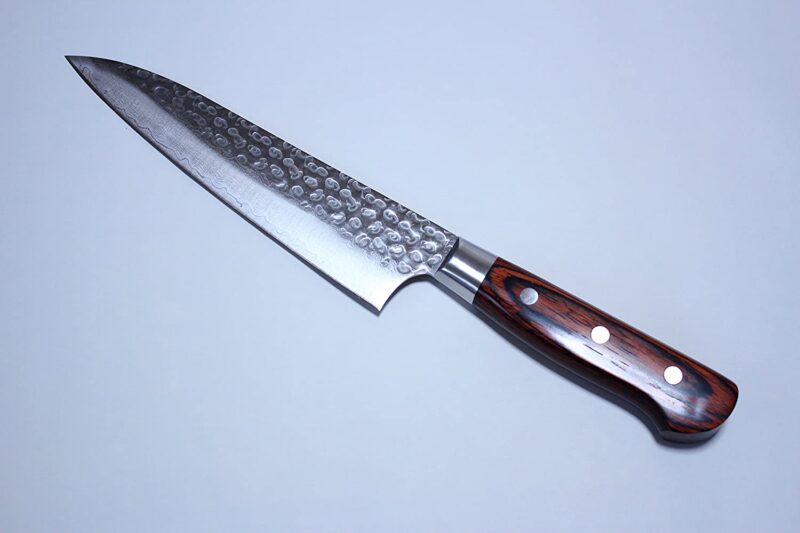
Takayuki Japanese knives are one of the few Japanese knife brands that assure users excellent workmanship and quality.
With a 600-year history of knife cultivation, Takayuki knives carry a reputation that won’t leave you with regret. The Sakai Takayuki 33-layered VG-10 Japanese knife is a stunning piece.
The stainless steel core and fine grain are very similar to Swedish steels down to the octagonal handle. It works well for both beginners and professional chefs.
The bolster is also crafted well, so it’s easy on your fingers when cutting and chopping. Finally, the Sakai Takayuki comes with a well-finished, thick spine, which means you’ll have better control when making delicate cuts.
PROS:
- Excellent workmanship and quality
- Great for both beginners and professionals
- Better control for delicate cutting
- Ergonomic design and handle
- Great sharpness
CONS:
- None we could find
Budget Pick: Tojiro DP Gyuto

For an affordable Japanese knife that can slice through tomatoes like butter, the Tojiro DP Gyuto Japanese knife is the ideal pick for a beginner.
Tojiro DP also scores a 60 on the Rockwell hardness scale and allows for easy maintenance and sharpening. This makes it even more suited to anyone who hasn’t had any experience handling Japanese knives.
If this is your first Gyuto Japanese knife, it’s even more ideal for you to have! Rather than invest in an expensive knife, going for a more affordable option will leave you more satisfied in the end.
Be careful, though! It’s impeccably sharp the moment you take it out of the box!
PROS:
- Budget-friendly
- Easy maintenance and sharpening
- Ideal for beginners
CONS:
- Heavier than most knives
Best Japanese Petty Knives
Blade Style: Double Bevel
Best Used For: Vegetable and Fruit paring
Another essential knife you should have in your kitchen and for professional chefs is the Petty knife. It may be small, typically between 120 to 150 mm in size, but don’t be fooled.
Petty knives are ideal for making delicate cuts in fruits and vegetables. Its blade is perfectly suited to handle peeling, decorating, and pairing tasks.
Thanks to its thin blade, Petty knives work best for carrying out detailed cuts such as removing the eyes from potatoes, brunoise cuts for shallots, etc.
In fact, every home or professional kitchen should never be without one.
Premium Pick: Enso Hammered Damascus 6-inch

The Enso Hammered Damascus Steel Petty knife is the best Japanese Petty knife for users looking for a balance between cutting performance and agility.
It may not have cutting-edge technology, but with a full-tang VG10 steel blade, it’s a fine craft to have in your kitchen. Not to mention its reasonable price, which costs half of the Dalstrong Shogun Series X.
Apart from its VG10 core, the blade is made of36 layers of Damascus steel cladding overlay, making it highly durable and stain, corrosion, & rust-resistant.
Whether you’re right-handed or left-handed, the Enso Hammered Damascus will suit either perfectly. As for the finishing touches, the handle is made of micarta, giving you that durable and long-lasting effect.
Put all together, it’s the best Japanese chef knife that offers great value for the price you pay.
PROS:
- Lifetime warranty
- Rustic charm
- Great value
- Suited to both professionals and beginners
- Long-lasting and durable
- Provides a balance between cutting performance & agility
- Works for both left-hand and right-hand users
CONS:
- Some users found the handle uncomfortable
Mid-Range Pick: Regalia Paring Knife AUS-10V 3.5-inch
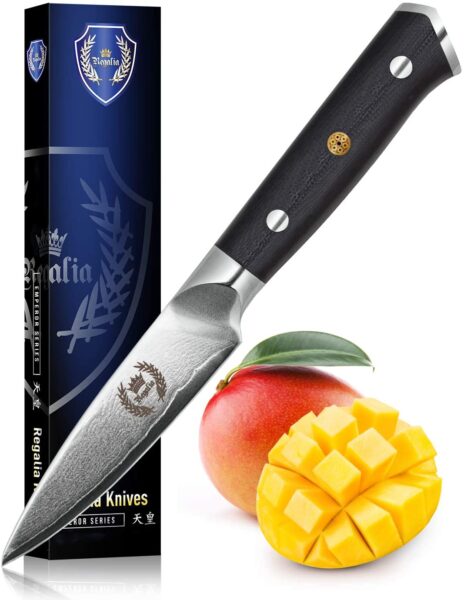
Now, you may not have heard of Regalia before, but this knife is one worth considering for a mid-range price point.
Here, Regalia combines good quality materials, a nice design, and good craftsmanship.
This blade is highly versatile in handling cheese, vegetables, fruits, steak, sausages, sandwiches, etc.
With a steel cutting core of 62+ Rockwell hardness and 67 layers of high-carbon stainless steel, you can expect impressive edge retention, long-lasting performance, strength, and stain-resistance.
Finally, it’s one of the best Japanese knives that also comes with an ergonomic handle and easy to clean feature. What’s not to love?
PROS:
- Suitable for professional chefs
- Lifetime guarantee & sharpening
- Rust, corrosion, and stain resistant
- Built to last a lifetime
- Good edge retention
CONS:
- Slightly heavier than you would expect
- The blade might be shorter than you’d like, depending on preference
Budget Pick: Seki Japan MASAMUNE 4.7 inch
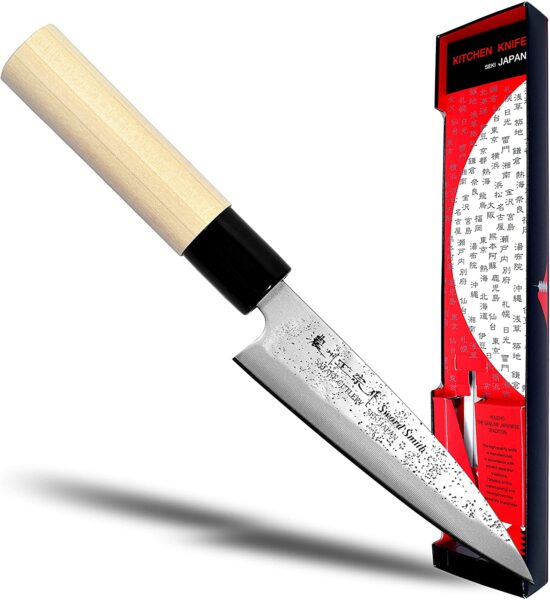
For something more affordable and a knife that gets the job done, you have the Seki Japan MASAMUNE 4.7 inch Petty knife.
This knife comes in impressively cheap, and it’s not so cheap that you’d be worried about its quality. As the brand name suggests, Seki city is well-known for its cutleries from Japanese swords down to letter openers.
Don’t let price dictate quality always. The Seki product line of Japanese knives is durable, reliable, and provides precise cuts. Seki knives are well known even overseas and not just in the local market.
With its stainless steel design, the Seki Japan is intended primarily for general-home use and even more suited to non-professional users.
PROS:
- Durable & reliable quality
- Highly affordable
- Low maintenance
- Rust-resistant
- Great for general-home use
CONS:
- Not suited for a professional chef
Best Japanese Sujihiki Knives
Blade Style: Double Bevel
Best Used For: Filleting/Slicing Meat, Poultry, and Fish
Being the meat-lover you are, having a Sujihiki knife is a must! Sujihiki is the best Japanese knife to have for finely slicing meat, skinning or filleting fish, and trimming fat and sinew from meat.
The blade is made with an acute edge angle and narrower than most blades, giving the Sujihiki knife its effortless cut through meat and other ingredients.
The short height of a Sujihiki blade also creates less friction as the blade slices through meat, fish, and poultry.
Not only is the Sujihiki one of the best Japanese chef knives to have, but it’s also a must for any home cook who frequently cooks meat or fish dishes.
Premium Pick: Shun Classic Premier 9.5-inch

Unlike most of the best Japanese knives on this list, the Shun Classic Premier has a super-steel core known as VGMAX, giving it more durability, ultra-sharp cutting edge, and delivering precise cuts to your meat.
With its double bevel edge ground to 16 degrees per side, cutting meat, poultry, or fish allows you to cut thinner portions while preserving the meat’s flavor and juices.
The cladding is also hand-hammered to give it a finish that reduces friction to cleanly release food.
Finally, its walnut-colored pakkawood non-slip handle makes this knife comfortable to use without worrying about accidental cuts on your fingers.
PROS:
- Well-balanced knife
- Extremely sharp
- Effortless cutting performance
- Handcrafted aesthetic appeal
- Lifetime warranty
- Dishwasher safe
CONS:
- Too expensive for some
- Not suited for beginners
Mid-Range Pick: Miyabi Fusion Morimoto Edition

The Fusion Morimoto line offers one of the best Japanese chef knives that merge Western and Japanese techniques.
What stood out, though, was the blade construction. Apart from its VG10 super steel alloy core, the blade was also tempered, ice-hardened, and hard-honed to create a 9.5 to 12-degree cutting angle for exquisite sharpness.
The handle is made of polyoxyethylene (POM) to ensure you get ergonomic comfort when handling the knife.
We love how the manufacturers crafted the blade and knife down to every last detail, even including the knife butt to prevent slippage when cutting.
PROS:
- Unique, stunning design
- Comfortable and responsive grip
- Great value for its performance
- Maximum sharpness
- Flexible blade
CONS:
- None we could find
Budget Pick: Tojiro DP Sujihiki Slicer
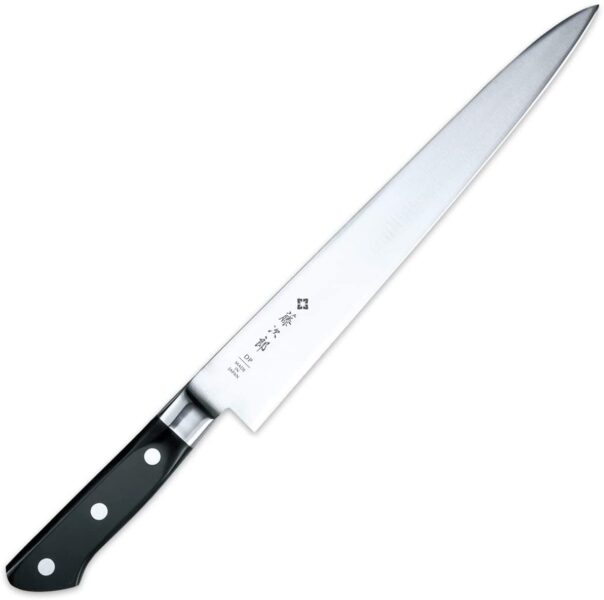
(Not to be confused with the Tojiro DP Gyuto from earlier!)
You can’t argue with the Tojiro DP’s value and price. It’s a steal for the performance it offers. If you’re looking for a great quality stainless steel Sujihiki knife, you can’t go wrong with the Tojiro DP.
It’s even suited to both right-hand and left-hand users! The best part? It’s perfect for both beginners and professional chefs.
Users especially commended the Tojiro DP for its outstanding performance when cutting tuna, sashimi, and meat!
PROS:
- Easy to maintain
- Budget-friendly
- Excellent value
- Suits well for beginners and professionals
- Great sharpness
CONS:
- Some users found the handle heavier than the blade
Best Japanese Nakiri Knives
Blade Style: Double Bevel
Best Used For: Vegetables
For a Japanese chef or even home cook, Nakiri knives are ideal for handling tough-skinned vegetables that most knives have a hard time slicing through.
Nakiri Japanese chef knives are also great for making precise cuts like the julienne.
Would you need this at home? Yes, indeed. Cutting vegetables such as celery root, butternut squash, rutabaga, jicama, etc. won’t be an easy task with an ordinary knife.
With a Nakiri knife, chopping vegetables is effortless and can even cut through hard animal bone. Since Nakiri Japanese chef knives closely resemble Western cleavers, these chef knives typically follow a push-pull cut motion.
Premium Pick: Shun Cutlery Classic 6.5-Inch

For a professional Japanese chef, the Shun Cutlery Classic has the ideal strength and sharpness to provide superb results be it trimming celery, julienning carrots, chopping peppers, or dicing onions!
This elegant handcrafted Japanese chef knife comes with a VG-MAX steel core and 68 layers of Damascus stainless steel for maximum durability and blade sharpness.
The blade edge angle is similar to the Shun Classic Premier Sujihiki Japanese chef knife, giving it precision cutting performance for any tough-skinned vegetable.
Its full-tang bolster also provides the Shun Cutlery Classic with a balance of strength and grip, not to mention its superb edge retention.
Overall, the Shun Cutlery Classic may be the priciest among all three best Nakiri Japanese chef knives, but its value is a bargain worth spending for.
PROS:
- Excellent cutting performance
- Superb edge retention
- Durable & Reliable
- Superb value
- Ideally suited for a professional Japanese chef
CONS:
- Handle could have better moisture-resistance
Mid-Range Pick: Mac Knife Japanese Series 6.5-inch

The Mac Japanese chef knife just might be your favorite knife for chopping vegetables.
A wide user base loved the Mac Japanese chef knife for its seamless cutting through tomatoes, onions, cabbage, etc. without mangling them.
What makes the Mac Japanese chef knife stand out from most Japanese chef knives on this list is its Molybdenum steel composition.
Compared to stainless steel, Molybdenum steel offers more corrosion resistance and higher temperature strength. Now for a knife that costs you less than $100, it’s undoubtedly a price that’s hard to say no to.
Having a thin blade and balanced weight, any home cook or professional chef will love the Mac Japanese chef knife’s cutting performance.
The only downside? Some vegetables like potato slices seem to stick to the knife at times, so you’ll have to push these off the blade as you cut.
PROS:
- Seamless cutting and edge retention
- Made of Molybdenum steel
- Superb value
- Works well for a Japanese chef and beginner
- Majority of reviews are positive
CONS:
- Some vegetables might stick to the blade at times
Budget Pick: Kotobuki Teruhisa

If you love the appeal of a traditional Japanese crafted knife, the Kotobuki Teruhisa is the best Japanese chef knife for you, and even better, it’s highly affordable!
For a Japanese chef knife that’s highly versatile in chopping various vegetables and easy to sharpen, you won’t have as much difficulty than traditional Japanese models.
The Magnolia handle also uniquely stood out. The wooden finish added even more appeal to this knife’s aesthetic blade design.
The only downside is the handle requires regular oiling and strict maintenance.
PROS:
- Traditional Japanese design appeal
- Highly affordable
- Easy to sharpen
- Versatile and flexible blade
- Great edge retention
CONS:
- Handle requires some oiling & maintenance
- Generally less sharp than the other recommendations
None of these float your boat? We have a whole article on the best nakiri knives. Check it out!
Best Japanese Deba Knives
Blade Style: Single Bevel
Best Used For: Fish Butchery
Deba is one of the more traditional Japanese chef knives used mainly for fish butchery, such as cutting the fish’s head and bones.
Because of their thick spine and heavyweight, Deba Japanese chef knives are perfect for butchery purposes. While they are also useful for butchering meat, it’s more commonly used for fish.
Premium Pick: Yoshihiro Hongasumi Blue Steel #2
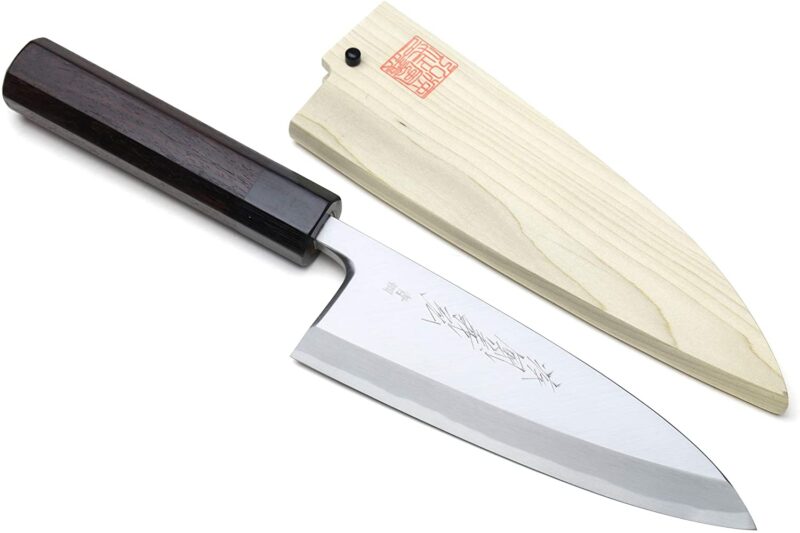
When you have a blade made of Blue Steel #2, you know the price tag is expected to be quite hefty.
This blade has the highest durable edge and hardness, although it has a shorter edge life than the Blue Steel Super.
Nonetheless, you can expect exquisite performance with a Blue Steel #2 blade, not to mention the single bevel style. The Yoshihiro Hongasumi is exceptionally sharp and can cut through the cartilage and bones of a fish seamlessly.
The handcrafted steel blade is also just as impressive: A Shingo (flat grind) on the front blade side and a Uroshi (flat rim) and Urasuki (concave grind) on the back side, which gives it excellent clean, unbroken cuts without damaging the cells.
Despite its cutting performance and sharpness, cutting through larger, harder bones in meat and poultry damages the blade.
PROS:
- Superb craftsmanship, performance, and quality
- Extremely sharp edge
- Octagonal handle for an ergonomic grip
- Reliable, sturdy build
CONS:
- Not stain-resistant
Mid-Range Pick: Kai Wasabi 6-inch Deba

With its high-carbon steel construction, the Kai Wasabi offers great edge retention, sharpening ease, and anti-corrosion properties.
It’s also one of the best Japanese chef knives that’s guaranteed to last. Kai knives are known for their reliability and long-lasting performance.
Its D-shaped handle also provides a stable grip that won’t be difficult even for beginners. Finally, this high-carbon steel knife is a perfect pick for anyone looking for a balance between performance, durability, and elegance.
PROS:
- Stable, ergonomic grip
- High-carbon steel construction
- Great edge retention
- Easy to sharpen
- Guaranteed to last
- Superb value
- Great for beginners
CONS:
- Not suited for cutting hard bones
Budget Pick: Mercer Culinary 6-inch with NSF Handle
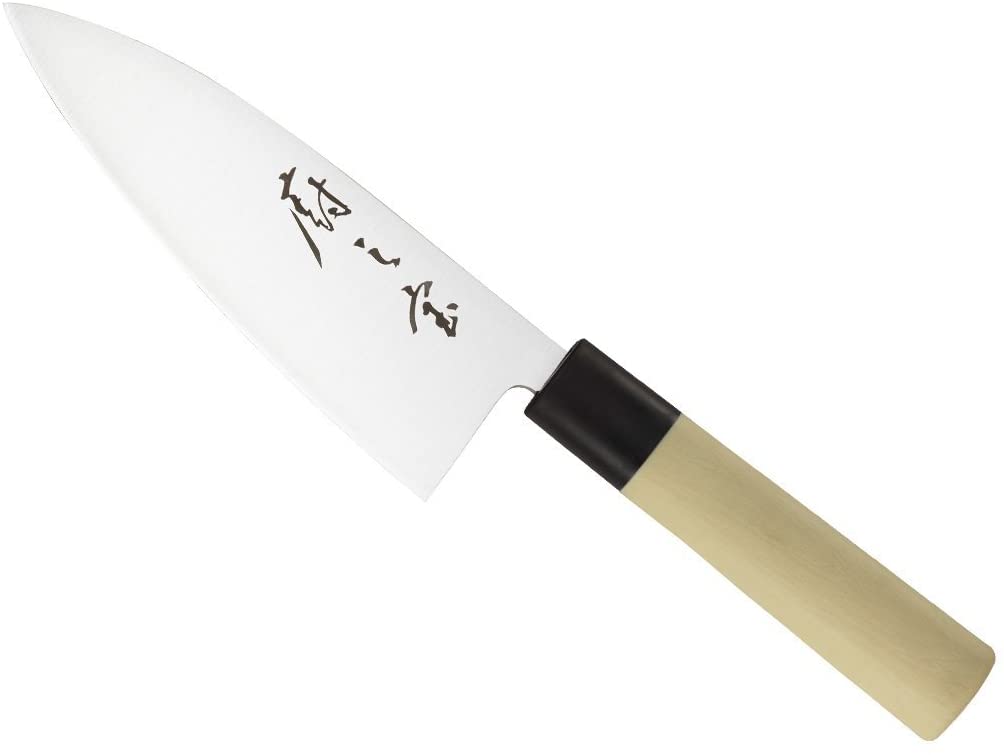
Affordability isn’t the only appeal of the Mercer Culinary. Its ability to cut paper-thin slices, filleting fish, and slicing/cubing meat makes it one of the best Japanese chef knives to have in both a home and commercial kitchen.
The NSF handle certification guarantees that it meets the standard requirements for safety, performance, reliability, and quality.
With its high-carbon German steel composition, the Mercer Culinary allows you to cut through various vegetable and meat types with ease.
Overall, its superb affordability, quality, and cutting performance makes it one of the best budget picks that would be a shame to miss out on.
PROS:
- Can handle various meats and vegetables
- NSF certified
- Superb affordability
- High-quality build and construction
- Ergonomic, non-slip handle
- Great precision cutting and control
CONS:
- Not dishwasher-friendly
Single Bevel Vs. Double Bevel
Throughout this review, you’ve noticed the terms “Single Bevel” and “Double Bevel,” which corresponds to the level of sharpness a knife has.
This is one of the most critical features a chef looks for, be it a Gyuto knife, Petty knife, Sujihiki knife, or even a vegetable knife.
Now, this may not be as important to your everyday home cook, but it plays a role in choosing among the best Japanese chef knives.
First, let’s go over single bevel knives.
Single Bevel Knife
We all know the edge of a knife is the sharpest part of a knife. As for the bevel, it corresponds to the angle leading to the edge of a knife.
The angle forms on one side of the knife only; however, single bevel knives are extremely sharp – even sharper than a double bevel knife.
For this reason, a single bevel knife is mostly preferred by a professional Japanese chef to perform intricate kitchen tasks or special cooking techniques.
Preparing a daikon vegetable, for example, requires delicate, unbroken cuts that only a single bevel knife can handle.
Since single bevel knives have an extremely sharp, fine edge, it’s more suited to handling delicate meat, fish, vegetables, and ingredients.
Double Bevel Knife
A double bevel knife is ideal for your average home cook since it’s more versatile in handling various, less intricate kitchen tasks.
When it comes to peeling long vegetables, cutting fish, or mincing, slicing, and dicing various ingredients, double-bevel knives are a preferred choice.
Should I Go For Single Bevel or Double Bevel?
You should only consider going for a single bevel knife if you’re working in a professional kitchen or aspiring to become a chef.
Remember, single bevel knives are ideally suited to making extra-thin cuts and are more useful in areas you’ll use special or fancy cutting techniques, commonly seen in the Kansai area.
Doube bevel knives are more common in Japanese households and are more suited to home cooks or beginners.
Best Japanese Knives (Single Bevel)
If you decide to go for a single bevel knife, here are a few knife types to go for:
Deba Knives – Deba knives are excellent knives used for butchering fish and require more experience to use. A Deba knife is similar to a Western-style filet knife that follows a three-piece or five-piece butchery style.
We recommend these Deba knives:
- Yoshihiro Hongasumi Blue Steel #2
- Mercer Culinary 6-inch with NSF Handle
- Kai Wasabi 6-inch
Yanagiba Knives – Yanagiba knives are best for a sushi chef. A Yanagiba knife is also especially long, allowing it to cut through nearly anything in a single slice rather than a back-and-forth motion.
A Yanagiba knife is also considered as a high-end sashimi knife that every professional sushi chef should have.
We recommend these Yanagiba knives:
- Yoshihiro Hongasumi VG-10 10.5-inch
- Tojiro DP 12-Inch
- Cangshan J Series VG-10
Honesuki Knives – Honesuki knives are Japanese boning knives mainly used for butchering meat and poultry. Although these aren’t as flexible as Western-style boning knives, it excels in carving as much meat off the animal as possible.
We recommend these Honesuki knives:
- Yoshihiro Inox Stain-Resistant AUS-10 5.75 inch
- Mac Knife Japanese Series 6-inch
- Tojiro Fujitora DP 5.9-inch
Usuba Knives – A Usuba knife is a vegetable knife for more experienced cooks or chefs.
For intricate vegetable cutting, this is the best knife to go for. Unlike the Nakiri, an Usuba knife takes much more skill to handle and master but can slice vegetables into exceptional, refined cuts when perfected.
We recommend these Usuba knives:
- Shun Edo 6.5-inch
- Zhen Japanese VG-10 7-inch
- Yoshihiro NSW 6.3 inch
How to Choose the Best Japanese Knife
Choosing the best Japanese chef knife depends on a lot of things, but here’s 4 main factors:
- Price
- Handle
- Blade Type
- Knife Type
Price
The prices of a Japanese chef knife can vary from as low as $20 to as high as $1000! An expensive knife will usually have a stronger steel composition, typically carbon, blue, or white steel.
Knives with more layers of Damascus steel will also have a higher price. Some can even go as high as 200 layers!
Before you invest in an expensive Japanese chef knife, take note that these require strict maintenance and regular sharpening. If misused, this can lead to your knife edge chipping off.
Cheaper knives will still come with a stainless steel composition, although at a lower spectrum than what a higher-priced knife would carry.
Still, cheaper doesn’t mean poor quality. You can find many affordable knives that are durable, easy to maintain, and have great sharpness.
The only drawback of buying a cheaper knife is the edge retention, meaning its sharpness won’t be as long-lasting.
Nevertheless, this shouldn’t be a concern for home cooks since you don’t use it as often as a higher-end knife used by professionals.
Handle
The knife handle comes in two styles: Western-style and traditional Japanese.
Western styles are heavier, sturdier, and built for cutting tasks that use brute force. Traditional Japanese typically comes with a wooden handle, are lightweight, and are cylindrical shaped.
Choosing the best handle depends on your personal preference.
Blade Type
As mentioned earlier, the blade type can come in either a single bevel or double bevel.
A single bevel knife is ideal for a professional chef, while a double bevel is more suited to general home purposes.
Knife Type
Japanese knives have many knife types such as Gyuto, Santoku, Nakiri, Yanagiba, Petty, Deba, etc.
For beginners, it’s essential to have either a Gyuto or Santoku, Petty, Nakiri, and Sujihiki knife. These are all great starter knives for beginners.
Advanced users or professionals will usually carry single bevel knives that require more experience to use, such as Yanagiba, Kuritsuke, Deba, Honesuki, Usuba, etc.
Final Words
Choosing the best Japanese chef knife isn’t a one-time pick. Over time, you’ll acquire techniques that will allow you to handle various knives and, eventually, land on the ideal knife of your preference.
Until then, as a beginner, we recommend starting with a Gyuto knife along with a Petty before diving into other knife types.
We hope this guide was able to help you choose the best Japanese knife!
![15 Best Japanese Knives for All Budgets [2025]](https://knivesadvisor.com/wp-content/uploads/2020/09/photo-1560291544-bc203f6f95be-1-min.jpg)